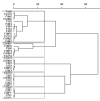Fermentation Pattern of Several Carbohydrate Sources Incubated in an In Vitro Semicontinuous System with Inocula from Ruminants Given Either Forage or Concentrate-Based Diets
- PMID: 32041290
- PMCID: PMC7070664
- DOI: 10.3390/ani10020261
Fermentation Pattern of Several Carbohydrate Sources Incubated in an In Vitro Semicontinuous System with Inocula from Ruminants Given Either Forage or Concentrate-Based Diets
Abstract
The fermentation pattern of several carbohydrate sources and their interaction with the nature of microbial inoculum was studied. Barley (B), maize (M), sorghum, (S), sugarbeet pulp (BP), citrus pulp (CP) and wheat bran (WB) were tested in an in vitro semicontinuous system maintaining poorly buffered conditions from 0 to 6 h, and being gradually buffered to 6.5 from 8 to 24 h to simulate the rumen pH pattern. Rumen fluid inoculum was obtained from lambs fed with either concentrate and barley straw (CI) or alfalfa hay (FI). The extent of fermentation was higher with CI than FI throughout the incubation (p < 0.05). Among the substrates, S, BP and M maintained the highest pH (p < 0.05), whereas CP recorded the lowest pH with both inocula. Similarly, CP recorded the highest gas volume throughout the incubation, followed by WB and B, and S recorded the lowest volume (p < 0.05). On average, the total volatile fatty acid (VFA), as well as lactic acid concentration, was higher with CP than in the other substrates (p < 0.05). The microbial structure was more affected by the animal donor of inoculum than by the substrate. The in vitro semicontinuous system allows for the study of the rumen environment acidification and substrate microbial fermentation under intensive feeding conditions.
Keywords: cereals; fibrous byproducts; gas volume; in vitro fermentation; pH; volatile fatty acids.
Conflict of interest statement
There were no conflicts of interest.
Figures



Similar articles
-
Fitting of the In Vitro Gas Production Technique to the Study of High Concentrate Diets.Animals (Basel). 2020 Oct 21;10(10):1935. doi: 10.3390/ani10101935. Animals (Basel). 2020. PMID: 33096765 Free PMC article. Review.
-
In vitro fermentation characteristics of diets with different forage/concentrate ratios: comparison of rumen and faecal inocula.J Sci Food Agric. 2011 May;91(7):1213-21. doi: 10.1002/jsfa.4302. Epub 2011 Feb 24. J Sci Food Agric. 2011. PMID: 21360539
-
Microbial fermentation of starch- or fibre-rich feeds added with dry or pre-activated Saccharomyces cerevisiae studied in vitro under conditions simulating high-concentrate feeding for ruminants.J Sci Food Agric. 2020 Mar 30;100(5):2236-2243. doi: 10.1002/jsfa.10249. Epub 2020 Jan 27. J Sci Food Agric. 2020. PMID: 31917481
-
In Vitro Estimation of the Effect of Grinding on Rumen Fermentation of Fibrous Feeds.Animals (Basel). 2020 Apr 23;10(4):732. doi: 10.3390/ani10040732. Animals (Basel). 2020. PMID: 32340162 Free PMC article.
-
Rumen Fermentation of Feed Mixtures Supplemented with Clay Minerals in a Semicontinuous In Vitro System.Animals (Basel). 2022 Jan 31;12(3):345. doi: 10.3390/ani12030345. Animals (Basel). 2022. PMID: 35158667 Free PMC article.
Cited by
-
In vitro Inoculation of Fresh or Frozen Rumen Fluid Distinguishes Contrasting Microbial Communities and Fermentation Induced by Increasing Forage to Concentrate Ratio.Front Nutr. 2022 Jan 14;8:772645. doi: 10.3389/fnut.2021.772645. eCollection 2021. Front Nutr. 2022. PMID: 35096928 Free PMC article.
-
Fitting of the In Vitro Gas Production Technique to the Study of High Concentrate Diets.Animals (Basel). 2020 Oct 21;10(10):1935. doi: 10.3390/ani10101935. Animals (Basel). 2020. PMID: 33096765 Free PMC article. Review.
-
Chemical Characterization and In Vitro Gas Production Kinetics of Alternative Feed Resources for Small Ruminants in the Maltese Islands.Metabolites. 2023 Jun 17;13(6):762. doi: 10.3390/metabo13060762. Metabolites. 2023. PMID: 37367919 Free PMC article.
References
-
- O’Brien L. Genotype and environment effects on feed grain quality. Aust. J. Agric. Res. 1999;50:703–719. doi: 10.1071/AR98162. - DOI
-
- Offner A., Bach A., Sauvant D. Quantitative review of in situ starch degradation in the rumen. Anim. Feed Sci. Technol. 2003;106:81–93. doi: 10.1016/S0377-8401(03)00038-5. - DOI
-
- De Peeters E.J., Fadel J.G., Arosemena A. Digestion kinetics of neutral detergent fiber and chemical composition within some selected by-product feedstuffs. Anim. Feed Sci. Technol. 1997;67:127–140. doi: 10.1016/0377-8401(96)01145-5. - DOI
Grants and funding
LinkOut - more resources
Full Text Sources
Miscellaneous

